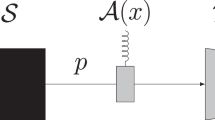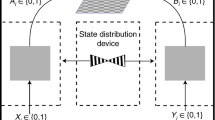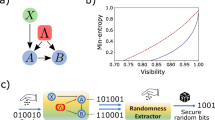Abstract
The concept of randomness plays an important part in many disciplines. On the one hand, the question of whether random processes exist is fundamental for our understanding of nature. On the other, randomness is a resource for cryptography, algorithms and simulations. Standard methods for generating randomness rely on assumptions about the devices that are often not valid in practice. However, quantum technologies enable new methods for generating certified randomness, based on the violation of Bell inequalities. These methods are referred to as device-independent because they do not rely on any modelling of the devices. Here we review efforts to design device-independent randomness generators and the associated challenges.
This is a preview of subscription content, access via your institution
Access options
Subscribe to this journal
Receive 51 print issues and online access
$199.00 per year
only $3.90 per issue
Buy this article
- Purchase on Springer Link
- Instant access to full article PDF
Prices may be subject to local taxes which are calculated during checkout



Similar content being viewed by others
References
Rukhin, A. et al. A Statistical Test Suite for Random and Pseudorandom Number Generators for Cryptographic Applications. NIST Special Publication 800-22rev1a, http://csrc.nist.gov/groups/ST/toolkit/rng/index.html (National Institute of Standards and Technology, 2010)
von Neumann, J. Various techniques used in connection with random digits. Natl Bureau Stand. Appl. Math. Ser. 12, 36–38 (1951)
Markowsky, G. The sad history of random bits. J. Cyber Secur. Mobil. 3, 1–24 (2014)
Bell, J. S. On the Einstein Podolsky Rosen paradox. Physics 1, 195–200 (1964)
Einstein, A., Podolsky, B. & Rosen, N. Can quantum-mechanical description of physical reality be considered complete? Phys. Rev. 47, 777–780 (1935)
Clauser, J. F., Horne, M. A., Shimony, A. & Holt, R. A. Proposed experiment to test local hidden-variable theories. Phys. Rev. Lett. 23, 880–884 (1969)
Khalfin, L. A. & Tsirelson, B. S. in Symposium on the Foundations of Modern Physics (eds Lahti, P. & Mittelstaedt, P. ) 441–460 (World Scientific, 1985)
Tsirelson, B. S. Some results and problems on quantum Bell-type inequalities. Hadronic J. 8 (Suppl.), 329–345 (1993)
Popescu, S. & Rohrlich, D. Quantum nonlocality as an axiom. Found. Phys. 24, 379–385 (1994)
Valentini, A. Signal-locality in hidden-variables theories. Phys. Lett. A 297, 273–278 (2002)
Barrett, J., Hardy, L. & Kent, A. No signaling and quantum key distribution. Phys. Rev. Lett. 95, 010503 (2005). A quantum key distribution protocol is described that is secure against non-signalling eavesdroppers on the basis of Bell inequality violations
Masanes, Ll ., Acín, A. & Gisin, N. General properties of nonsignaling theories. Phys. Rev. A 73, 012112 (2006)
Barrett, J., Kent, A. & Pironio, S. Maximally non-local and monogamous quantum correlations. Phys. Rev. Lett. 97, 170409 (2006)
Colbeck, R. Quantum and Relativistic Protocols for Secure Multi-party Computation. PhD Thesis, Univ. Cambridge (2006); preprint at http://arxiv.org/abs/0911.3814. Chapter 5 of this thesis introduces the idea of private randomness generation certified by Bell inequality violations.
Pironio, S. et al. Random numbers certified by Bell’s theorem. Nature 464, 1021–1024 (2010). This paper presents a general construction of device-independent randomness expansion protocols and an experimental demonstration thereof.
Hall, M. J. W. Complementary contributions of indeterminism and signalling to quantum correlations. Phys. Rev. A 82, 062117 (2010)
Colbeck, R. & Kent, A. Private randomness expansion with untrusted devices. J. Phys. A 44, 095305 (2011)
Vazirani, U. V. & Vidick, T. Certifiable quantum dice. Phil. Trans. R. Soc. Lond. A 370, 3432–3448 (2012)
Coudron, M. & Yuen, H. Infinite randomness expansion and amplification with a constant number of devices. In Proc. 46th Annual ACM Symposium on Theory of Computing 427–436 (ACM New York, 2014)
Miller, C. A. & Shi, Y. Robust protocols for securely expanding randomness and distributing keys using untrusted quantum devices. In Proc. 46th Annual ACM Symposium on Theory of Computing 417–426 (ACM New York, 2014)
Chung, K. M., Shi, Y. & Wu, X. Physical randomness extractors: generating random numbers with minimal assumptions. Preprint at http://arxiv.org/abs/1402.4797 (2015)
Miller, C. A. & Shi, Y. Universal security for randomness expansion from the spot-checking protocol. Preprint at http://arxiv.org/abs/1411.6608 (2015)
Arnon-Friedman, R., Renner, R. & Vidick, T. Simple and tight device-independent security proofs. Preprint at http://arxiv.org/abs/1607.01797 (2016)
Colbeck, R. & Renner, R. Free randomness can be amplified. Nat. Phys. 8, 450–454 (2012)
Gallego, R. et al. Full randomness from arbitrarily deterministic events. Nat. Commun. 4, 2654 (2013)
Brandão, F. G. S. L. et al. Robust device-independent randomness amplification with few devices. Nat. Commun. 7, 11345 (2016)
Bouda, J., Pawlowski, M., Pivoluska, M. & Plesch, M. Device-independent randomness extraction for arbitrarily weak min-entropy source. Phys. Rev. A 90, 032313 (2014)
Ramanathan, R. et al. Randomness amplification against no-signaling adversaries using two devices. Preprint at http://arxiv.org/abs/1504.06313 (2015)
Wojewódka, H. et al. Amplifying the randomness of weak sources correlated with devices. Preprint at http://arxiv.org/abs/1601.06455 (2016)
Santha, M. & Vazirani, U. Generating quasi-random sequences from slightly-random sources. In Proc. 25th IEEE Symposium on Foundations of Computer Science 434–440 (IEEE, 1984)
Mayers, D. & Yao, A. Self testing quantum apparatus. Quantum Inf. Comput. 4, 273–286 (2004). This work introduces the idea of quantum information protocols with untrusted devices.
Acín, A., Gisin, N. & Masanes, L. From Bell’s theorem to secure quantum key distribution. Phys. Rev. Lett. 97, 120405 (2006)
Acín, A. et al. Device-independent security of quantum cryptography against collective attacks. Phys. Rev. Lett. 98, 230501 (2007)
Masanes, L. Universally-composable privacy amplification from causality constraints. Phys. Rev. Lett. 102, 140501 (2009)
Pironio, S. et al. Device-independent quantum key distribution secure against collective attacks. New J. Phys. 11, 045021 (2009)
Hänggi, E. & Renner, R. Device-independent quantum key distribution with commuting measurements. Preprint at http://arxiv.org/abs/1009.1833 (2010)
Masanes, L., Pironio, S. & Acín, A. Secure device-independent quantum key distribution with causally independent measurement devices. Nat. Commun. 2, 238 (2011)
Masanes, L., Renner, R., Christandl, M., Winter, A. & Barrett, J. Full security of key distribution from no-signaling constraints. IEEE Trans. Inf. Theory 60, 4973–4986 (2014)
Barrett, J., Colbeck, R. & Kent, A. Unconditionally secure device-independent quantum key distribution with only two devices. Phys. Rev. A 86, 062326 (2012)
Reichardt, B., Unger, F. & Vazirani, U. Classical command of quantum systems. Nature 496, 456–460 (2013)
Barrett, J., Colbeck, R. & Kent, A. Memory attacks on device-independent quantum cryptography. Phys. Rev. Lett. 110, 010503 (2013)
Vazirani, U. & Vidick, T. Fully device independent quantum key distribution. Phys. Rev. Lett. 113, 140501 (2014)
Pearle, P. Hidden-variable example based upon data rejection. Phys. Rev. D 2, 1418–1425 (1970)
Massar, S. & Pironio, S. Violation of local realism vs detection efficiency. Phys. Rev. A 68, 062109 (2003)
Acín, A., Cavalcanti, D., Passaro, E., Pironio, S. & Skrzypczyk, P. Necessary detection efficiencies for secure quantum key distribution and bound randomness. Phys. Rev. A 93, 012319 (2016)
Rowe, M. A. et al. Experimental violation of a Bell’s inequality with efficient detection. Nature 409, 791–794 (2001)
Matsukevich, D. N., Maunz, P., Moehring, D. L., Olmschenk, S. & Monroe, C. Bell inequality violation with two remote atomic qubits. Phys. Rev. Lett. 100, 150404 (2008)
Hofmann, J. et al. Heralded entanglement between widely separated atoms. Science 337, 72–75 (2012)
Giustina, M. et al. Bell violation with entangled photons, free of the fair-sampling assumption. Nature 497, 227–230 (2013)
Christensen, B. G. et al. Detection-loophole-free test of quantum nonlocality, and applications. Phys. Rev. Lett. 111, 130406 (2013). This paper provides an experimental demonstration of device-independent randomness expansion using entangled photons.
Hensen, B. et al. Loophole-free Bell inequality violation using electron spins separated by 1.3 kilometres. Nature 526, 682–686 (2015). An experimental Bell violation, free of the detection and locality loopholes, is demonstrated using entangled nitrogen-vacancy centres.
Giustina, M. et al. Significant-loophole-free test of Bell’s theorem with entangled photons. Phys. Rev. Lett. 115, 250401 (2015). An experimental Bell violation, free of the detection and locality loopholes, is demonstrated using entangled photons.
Shalm, L. K. et al. A strong loophole-free test of local realism. Phys. Rev. Lett. 115, 250402 (2015). An experimental Bell violation, free of the detection and locality loopholes, is demonstrated using entangled photons.
Aspect, A. Proposed experiment to test separable hidden-variable theories. Phys. Lett. A 54, 117–118 (1975)
Kent, A. Causal quantum theory and the collapse locality loophole. Phys. Rev. A 72, 012107 (2005)
Scheidl, T. et al. Violation of local realism with freedom of choice. Proc. Natl Acad. Sci. USA 107, 19708–19713 (2010)
Pironio, S. Random ‘choices’ and the locality loophole. Preprint at http://arxiv.org/abs/1510.00248 (2015)
zżukowski, M., Zeilinger, A., Horne, M. A. & Ekert, A. K. “Event-ready-detectors” Bell experiment via entanglement swapping. Phys. Rev. Lett. 71, 4287–4290 (1993)
Simon, C. & Irvine, W. T. M. Robust long-distance entanglement and a loophole-free Bell test with ions and photons. Phys. Rev. Lett. 91, 110405 (2003)
Hensen, B. et al. Loophole-free Bell test using electron spins in diamond: second experiment and additional analysis. Sci. Rep. 6, 30289 (2016)
Pawłowski, M. & Brunner, N. Semi-device-independent security of one-way quantum key distribution. Phys. Rev. A 84, 010302(R) (2011)
Li, H.-W., Pawłowski, M., Yin, Z.-Q., Guo, G.-C. & Han, Z.-F. Semi-device-independent randomness certification using n → 1 quantum random access codes. Phys. Rev. A 85, 052308 (2012)
Gallego, R., Brunner, N., Hadley, C. & Acín, A. Device-independent tests of classical and quantum dimensions. Phys. Rev. Lett. 105, 230501 (2010)
Bowles, J., Quintino, M. T. & Brunner, N. Certifying the dimension of classical and quantum systems in a prepare-and-measure scenario with independent devices. Phys. Rev. Lett. 112, 140407 (2014)
Lunghi, T. et al. A self-testing quantum random number generator. Phys. Rev. Lett. 114, 150501 (2015)
Wiseman, H. M., Jones, S. J. & Doherty, A. C. Steering, entanglement, nonlocality, and the EPR paradox. Phys. Rev. Lett. 98, 140402 (2007)
Branciard, C., Cavalcanti, E. G., Walborn, S. P., Scarani, V. & Wiseman, H. M. One-sided device-independent quantum key distribution: security, feasibility, and the connection with steering. Phys. Rev. A 85, 010301(R) (2012)
Smith, D. H. et al. Conclusive quantum steering with superconducting transition edge sensors. Nat. Commun. 3, 625 (2012)
Bennet, A. J. et al. Arbitrarily loss-tolerant Einstein–Podolsky–Rosen steering allowing a demonstration over 1 km of optical fiber with no detection loophole. Phys. Rev. X 2, 031003 (2012)
Wittmann, B. et al. Loophole-free Einstein–Podolsky–Rosen experiment via quantum steering. New J. Phys. 14, 053030 (2012)
Tomamichel, M., Fehr, S., Kaniewski, J. & Wehner, S. A monogamy-of-entanglement game with applications to device-independent quantum cryptography. New J. Phys. 15, 103002 (2013)
Colbeck, R. & Renner, R. No extension of quantum theory can have improved predictive power. Nat. Commun. 2, 411 (2011)
Colbeck, R. & Renner, R. Is a system’s wave function in one-to-one correspondence with its elements of reality? Phys. Rev. Lett. 108, 150402 (2012)
Dhara, C., de la Torre, G. & Acín, A. Can observed randomness be certified to be fully intrinsic? Phys. Rev. Lett. 112, 100402 (2014)
Barrett, J. et al. Non-local correlations as an information theoretic resource. Phys. Rev. A 71, 022101 (2005)
de la Torre, G., Hoban, M. J., Dhara, C., Prettico, G. & Acín, A. Maximally nonlocal theories cannot be maximally random. Phys. Rev. Lett. 114, 160502 (2015)
Acín, A., Massar, S. & Pironio, S. Randomness versus nonlocality and entanglement. Phys. Rev. Lett. 108, 100402 (2012)
Acín, A., Pironio, S., Vértesi, T. & Wittek, P. Optimal randomness certification from one entangled bit. Phys. Rev. A 93, 040102 (2016)
Curchod, F. J. et al. Unbounded randomness certification using sequences of measurements. Preprint at http://arxiv.org/abs/1510.03394 (2015)
Ansmann, M. et al. Violation of Bell’s inequality in Josephson phase qubits. Nature 461, 504–506 (2009)
Dehollain, J. P. et al. Bell’s inequality violation with spins in silicon. Nat. Nanotechnol. 11, 242–246 (2016)
Neeley, M. et al. Generation of three-qubit entangled states using superconducting phase qubits. Nature 467, 570–573 (2010)
DiCarlo, L. Preparation and measurement of three-qubit entanglement in a superconducting circuit. Nature 467, 574–578 (2010)
Silman, J., Pironio, S. & Massar, S. Device-independent randomness generation in the presence of weak cross-talk. Phys. Rev. Lett. 110, 100504 (2013)
Máttar, A., Skrzypczyk, P., Brask, J. B., Cavalcanti, D. & Acín, A. Optimal randomness generation from optical Bell experiments. New J. Phys. 17, 022003 (2015)
Thinh, L. P., de la Torre, G., Bancal, J.-D., Pironio, S. & Scarani, V. Randomness in post-selected events. New J. Phys. 18, 035007 (2016)
Barrett, B., Collins, D., Hardy, L., Kent, A. & Popescu, S. Quantum nonlocality, Bell inequalities and the memory loophole. Phys. Rev. A 66, 042111 (2002)
Navascués, M., Pironio, S. & Acín, A. Bounding the set of quantum correlations. Phys. Rev. Lett. 98, 010401 (2007)
Navascués, M., Pironio, S. & Acín, A. A convergent hierarchy of semidefinite programs characterizing the set of quantum correlations. New J. Phys. 10, 073013 (2008)
Nieto-Silleras, O., Pironio, S. & Silman, J. Using complete measurement statistics for optimal device-independent randomness evaluation. New J. Phys. 16, 013035 (2014)
Trevisan, L. Extractors and pseudorandom generators. J. Assoc. Comput. Mach. 48, 860–879 (2001)
Nisan, N. & Ta-Shma, A. Extracting randomness: a survey and new constructions. J. Comput. Syst. Sci. 58, 148–173 (1999)
Canetti, R. Universally composable security: a new paradigm for cryptographic protocols. In Proc. 42nd IEEE Symposium on Foundations of Computer Science 136–145 (IEEE, 2001)
Acknowledgements
We thank S. Pironio, V. Scarani, F. G. S. L. Brandao, R. Arnon Friedman and A. Wallraff for discussions. A.A. acknowledges support from the ERC CoG QITBOX, the AXA Chair in Quantum Information Science, Spanish MINECO (FOQUS FIS2013-46768-P and SEV-2015-0522), Fundación Cellex, the Generalitat de Catalunya (SGR 875) and The John Templeton Foundation. L.M. is supported by EPSRC.
Author information
Authors and Affiliations
Contributions
Both authors equally contributed to the work.
Corresponding author
Ethics declarations
Competing interests
The authors declare no competing financial interests.
Rights and permissions
About this article
Cite this article
Acín, A., Masanes, L. Certified randomness in quantum physics. Nature 540, 213–219 (2016). https://doi.org/10.1038/nature20119
Received:
Accepted:
Published:
Issue Date:
DOI: https://doi.org/10.1038/nature20119
This article is cited by
-
Semi-device-independent quantum random number generator with a broadband squeezed state of light
npj Quantum Information (2024)
-
Nonlocality activation in a photonic quantum network
Nature Communications (2024)
-
Physical Time and Human Time
Foundations of Physics (2024)
-
Experimental nonclassicality in a causal network without assuming freedom of choice
Nature Communications (2023)
-
Quantum random number generation based on a perovskite light emitting diode
Communications Physics (2023)
Comments
By submitting a comment you agree to abide by our Terms and Community Guidelines. If you find something abusive or that does not comply with our terms or guidelines please flag it as inappropriate.



